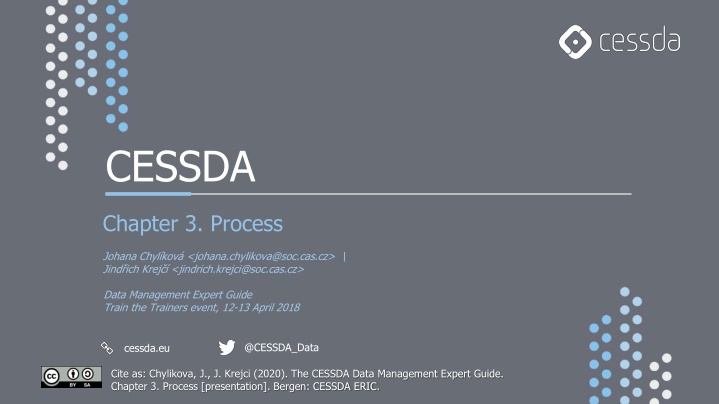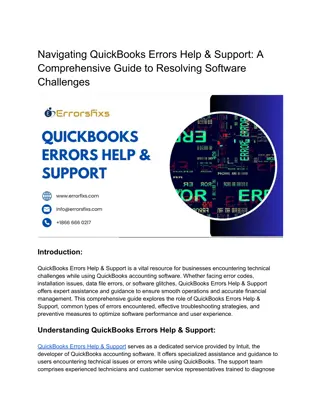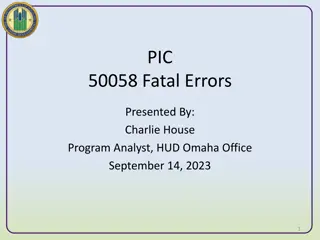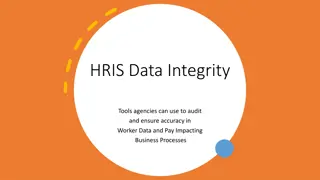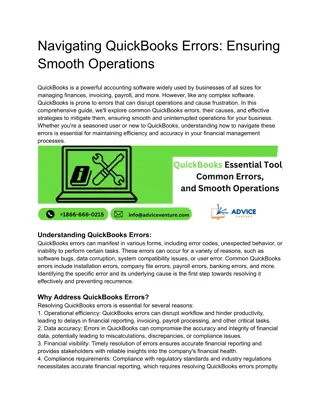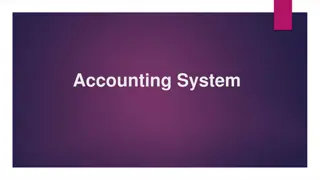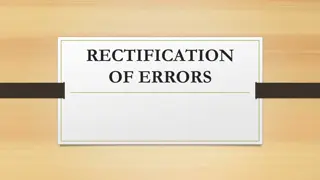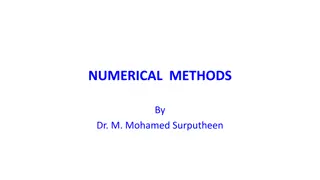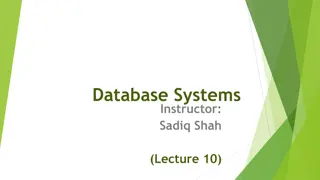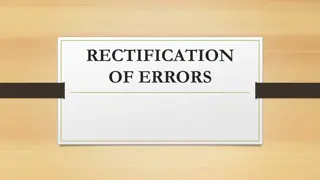Effective Strategies for Data Entry Integrity and Minimizing Errors
The chapter and subchapter discuss the importance of data integrity in the data management process, specifically focusing on data entry procedures, authenticity, and minimizing errors. It covers traditional manual data entry methods versus newer automated technologies, such as CAPI, and offers strategies for reducing errors in manual data entry through thorough checks and validations. The content emphasizes logical and consistency checks, comparing data with historical records, and the use of automated checks to ensure accuracy.
Download Presentation

Please find below an Image/Link to download the presentation.
The content on the website is provided AS IS for your information and personal use only. It may not be sold, licensed, or shared on other websites without obtaining consent from the author.If you encounter any issues during the download, it is possible that the publisher has removed the file from their server.
You are allowed to download the files provided on this website for personal or commercial use, subject to the condition that they are used lawfully. All files are the property of their respective owners.
The content on the website is provided AS IS for your information and personal use only. It may not be sold, licensed, or shared on other websites without obtaining consent from the author.
E N D
Presentation Transcript
CESSDA Chapter 3. Process Johana Chyl kov <johana.chylikova@soc.cas.cz> \ Jind ich Krej <jindrich.krejci@soc.cas.cz> Data Management Expert Guide Train the Trainers event, 12-13 April 2018 @CESSDA_Data cessda.eu Cite as: Chylikova, J., J. Krejci (2020). The CESSDA Data Management Expert Guide. Chapter 3. Process [presentation]. Bergen: CESSDA ERIC.
What is the chapter Process about? Data entry and integrity Quantitative coding Qualitative coding __________________________ Weights of survey data File formats and data conversion Data authenticity
Subchapter: Data entry Data entry and data integrity Data integrity = stored data should correspond to gathered data = assurance of preservationof original information contained in the data. Stored data <=> original information from the research Data authenticity It is important to mention = in the data processing, data integrity is at stake.
Data entry: Quantitative data Survey data: Data entry procedures have changed over the recent years: BEFORE: manual data entry (phases: data collection, data entry, data editing/checking) NOW: computer technologies, automated data entry (CAPI) Automatic data entry: prevents some types of errors, but produces others. Errors in scripts in CAPI may cause systematic shifts in data; example: gender of a respondent is programmed wrongly all analyses regarding gender are wrong
Minimizing errors in manual data entry I. Reduce burden on those who enter data manually Check the completeness of records (cases, variables) Conduct data entry twice: approx. 20 percent of questionnaires entered twice by two different persons compare values, if difference in single value, get back to questionnaire and enter the right value. Perform in depth checks for selected records: randomly selected records, e.g. 5 10% of all records subject of more detailed, in-depth check. Questionnaire scanning: (=data not entered manually, but scanned) do scanning twice, compare values
Minimizing errors in manual data entry II. Perform logical and consistency checks: Check minimal and maximal values of variables, Check the relations between associated variables (r(education;age)); Compare your data with historical data (e.g. check the number of household members with the previous wave of a panel survey). Automated checks - CAPI, data entry software: set the range of valid values apply filters to manage the data entry CAPI software= used by the data collectors; expensive; individuals can't afford it. Write your own program or syntax to check for discrepancies. An example of a SPSS syntax to check your data Logical check of income: The household income cannot be SMALLER than individual income
Minimizing errors in manual data entry II. Variable names: ide.10 - household income = interval variable, income in Euros, with special values 8 - refused to answer; 9 - don t know ide.10a - individual income = interval variable, income in Euros, with special values 8 - refused to answer; 7 - doesn t have income CD respondents identification Syntax (SPSS): USE ALL. COMPUTE filter_$=(ide.10a ne 0) and (ide.10 ne 0) and (ide.10a ne 7) and (ide.10a ne 8) and (ide.10 ne 8) and (ide.10 ne 9) and (ide.10 < ide.10a). VARIABLE LABELS filter_$ '(ide.10a ne 0) and (ide.10 ne 0) and (ide.10a ne 7) and (ide.10a ne 8) and (ide.10 ne 8) and (ide.10 ne 9) and (ide.10 < ide.10a) (FILTER)'. VALUE LABELS filter_$ 0 'Not Selected' 1 'Selected'. FORMATS filter_$ (f1.0). FILTER BY filter_$. EXECUTE. FREQUENCIES VARIABLES=CD /ORDER=ANALYSIS. FILTER OFF. USE ALL.
What to do with error values? (tricky) e.g. Suspicious values Comparison with respondents original answers. Inconsistencies can be generated by the respondents themselves (true value not known) Delete? Correct? Keep? Single right recipe does not exist Think twice, document changes.
Data entry: Qualitative data Transcription The most common formats of qualitative data = written texts, interview data and focus group discussion data; Record -> Transcribe; Transcription = conversion of audio or video recordings into text. If you intend to share your data with other researchers, you should prepare a full transcription of your recordings; If the transcription is not in English, prepare summary in English.
Basic rules for transcriptions Record in high quality, so you can hear/see everything (equipment, quite place). Transcription method: several methods exist Speech recognition software: good servant, but must be well set up, expensive Alone or in a team: Determine a set of transcription rules/ transcription guidelines: All members of a transcript team should first agree on these rules; you yourself should have rules Anonymise protection Choose a file format for the long time preservation Anyone has a comment/ transcription story from their own experience (software, complications, working in a team, anonymisation)?
Subchapter: Quantitative coding = coding answers to questionnaire items, assigning values to answers _________________ Closed ended questions/questionnaire items Codes incoporated in survey questionnaires (individual response categories have values/codes) In (CAPI, CATI, etc.) an answer and its code are saved immediately into a computer in the course of data collection Open ended questions/questionnaire items e.g. textual answers in survey questionnaires Require an independent coding process with a clearly defined rules
Coding recommendations: Make code categories exclusive and coherent throughout the database Preserve original information Document the coding schemes Check verbatim text data (open questions) for data disclosure risk -> privacy Distinguish between major and lower level categories - Example ISCO Standardized coding scheme
Example of standardized coding scheme Example of standardized coding scheme Standard Classification of Occupations (ISCO): widespread standard coding scheme; hierarchical category scheme - several dimensions (data collection = one or more open-ended questions) The current ISCO-2008 uses four-digit codes. In the table below you see some examples. 2 Professionals 21 Science and engineering professionals 211 Physical and earth science professionals 2111 Physicists and astronomers 2112 Meteorologists 2113 Chemists 2114 Geologists and geophysicists 212 Mathematicians, actuaries and statisticians 2120 Mathematicians, actuaries and statisticians 213 Life science professionals 2131 Biologists, botanists, zoologists and related professionals 2132 Farming, forestry and fisheries advisers 2133 Environmental protection professionals 214 Engineering professionals (excluding electrotechnology) 2141 Industrial and production engineers 2142 Civil engineers
Exercise: Download Part 2: Classification Structure http://www.ilo.org/public/english/bureau/stat/isco/isco08/ Answer to an open question in a questionnaire: I work in a hospital as a nurse and I take care of newborns Find a code for this profession Find a code for your own profession
Coding missing values Item non-response or when values are missing from other reasons: No answer (NA): The respondent did not answer a question when he/she should have; Refusal: The respondent explicitly refused to answer; Don t Know (DK): The respondent did not answer a question because he/she had no opinion or did not know the information required for answering. Processing Error: The respondent provided an answer; interviewer error, illegible record, incorrect coding etc Not Applicable/Inapplicable (NAP/INAP): A question did not apply to the respondent. For example respondents without a partner did not answer partner- related questions For more missing data situations see ETG
Coding missing values Numerical codes of missing values: Typically negative values or values like 7, 8, 9 or 97, 98, 99 or 997, 998, 999. Prevent overlapping codes for valid and missing values. Example: 0 may be a real value (income, years of duration of something), do not use 0 as a code for missing value.
Subchapter: Qualitative coding !!! Completely different from quantitative coding!!! What s in the text? What is it about? A process of identifying a passage in the text or other data items (photograph, image). Searching and identifying concepts and finding relations between them. Codes enable you to organise and analyse data in a structured way, e.g. by examining relationships between codes. Qualitative coding dependenst on your expertise!! It is not the aim of this presentation to teach you qualitative coding, only hint some basics.
Concept driven coding vs data driven coding Concept driven approach: deductive, you have a developed system of codes representing concepts and look for concepts in the text Data driven approach: inductive, you search concepts in the text without a preceding conceptualisation and let the text speak for itself Example of coding:
Documenting codes Document the meaning of the codes in a separate file. Short descriptions of the meaning of each code. Necessary to you and others who will have access to your data/analysis. Provide other information to the code: the label or name of the code who coded it (name of the researcher/coder) the date when the coding was done/changed definition of the code; a description of the concept it refers to information about the relationship of the code to other codes you are working with during the analysis.
Prevent coder variance The coder has influence on the coding process. Establish coding guidelines Each coder in the team must be trained according to guidelines Several techniques to control coder reliability: Checking the transcription An independent researcher goes through coded texts and considers a degree to which coders differed from each other.
Definitional drift in coding Coding large dataset, at the beginnings feelings and perceptions of the coder different from those at the end When you finish coding the document, check for the definitional drift Have good notes with descriptions of individual codes. Working in a team: If there are more people in the team, individual members can check each other s coding.
Dive in deep? Weights of survey data Adjustment of the sample. Each individual case in the file is assigned an individual weight which is used to multiply the case in order to attain the desired characteristics of the sample. There are different types of weights for different purposes Necessary in some sitations Issue of quality
Issue of quality Distribution of weighting variable - how the post-stratification weight should not look VAHA 30 00 20 00 10 00 Frequenc Std. Dev = ,90 Mean = ,99 y 0 N = 75 49,00 VAHA
Example - Marcin W. Zieliski: Weighting issue or weighting problem - international survey projects in a comparative perspective; CSDA Workshop on Challenges in the Organisation of International Comparative Social Surveys; http://archiv.soc.cas.cz/sites/default/files/zielinski_weighting_issue.pdf Technically good weight : mean(wght) = 1; sd(wght) as small as possible; MIN(wght) > 0 and MIN(wght) < 1; MAX(wght) > 1 but small sd(weight)
File formats and data conversion Short-term data processing: file formats for operability Proprietary vs. open formats Export / portable formats Long-term data preservation Link to the table of Recommended file formats PDF/A, CSV, TIFF, ASCII, Open Document Format (ODF), XML, Office Open XML, JPEG 2000, PNG, SVG, HTML, XHTML, RSS, CSS, etc.
Data authenticity Preserving the authenticity of the original research information contained in the data throughout the whole data lifecycle. Data cleaning; correcting errors; constructing new variables; adding new information from external sources; changing formats; changing data file structure... Different versions of the data file; New editions,
Version control Unique identification; naming convention; version numbering Record the date Don't use ambiguous descriptions for the version (NO: MyThesisFinal.doc, MyThesisLastOne.doc) Designing and using a version control table Version control facilities; versioning software File-sharing services with incorporated version control (but be aware of specific rules at, e.g., Google cloud, Dropbox...) Title Description Created By Date Created Maintained By Version Number Modified By Modifications Made Date Modified Status
Versioning new data types Enable reproducibility and support trustworthiness by allowing all transformations in the data to be traced is more difficult with new data as these data are (compared to traditional data ) more frequently or even continuously updated. Collections of Tweets and individual posts may be modified or deleted. As the contents of these data are continuously changing and if archived data are expected to reflect such changes; This result is an increasing number of versions. Consequently, it is necessary to develop a systematic plan to create and name new versions of constantly changing datasets, or find new solutions for streaming data.
Versioning new data types: emerging issues for data archiving and citing The most common version control software in software development is Git. Some of the established repositories, such as Zenodo and FigShare or the Open Science Framework, now offer integration with GitHub, so that every version of data sets in those repositories can be recorded through it. A new project called Dolt is developing version control specifically for data which is particularly interesting for dynamic data sets, such as social media data. To identify the exact version of a dataset as it was used in a specific project or publication, the Research Data Alliance (RDA) suggests that every dataset is versioned, timestamped, and assigned a persistent identifier (PID). In the case of Big Data, however, the RDA warns against excessive versioning: In large data scenarios, storing all revisions of each record might not be a valid approach. Therefore in our framework, we define a record to be relevant in terms of reproducibility, if and only if it has been accessed and used in a data set. Thus, high-frequency updates that were not ever read might go - from a data citation perspective - unversioned.
Wrap up: Data quality Small things matter: "The quality of a survey is best judged not by its size, scope, or prominence, but by how much attention is given to [preventing, measuring and] dealing with the many important problems that can arise." | American Association for Public Opinion Research (2015) (AAPOR) "In qualitative research, discussions about quality in research are not so much based on the idea of standardization and control, as this seems incompatible with many qualitative methods. Quality is rather seen as an issue of how to manage it. Sometimes it is linked to rigour in applying a certain method, but more often to soundness of the research as a whole" | Flick (2007). A complex approach to data quality: "The mechanical quality control of survey operations such as coding and keying does not easily lend itself to continuous improvement. Rather, it must be complemented with feedback and learning where the survey workers themselves are part of an improvement process" | Biemer & Lyberg (2003).
Data Management Expert Guide. Train the Trainers event, 12-13 April 2018 Johana Chyl kov <johana.chylikova@soc.cas.cz> \ Jind ich Krej <jindrich.krejci@soc.cas.cz> @CESSDA_Data cessda.eu
